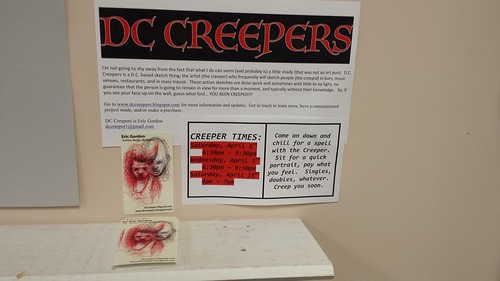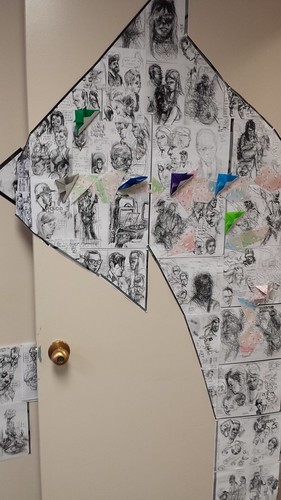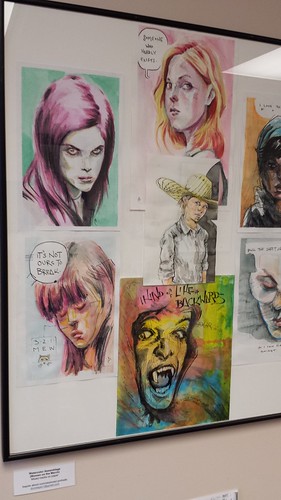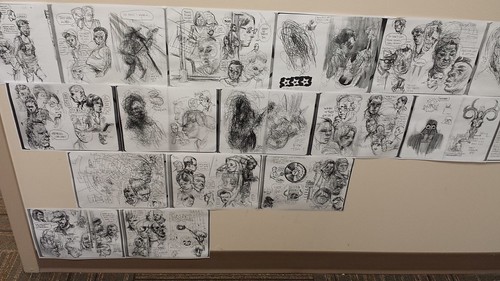 |
| Liza Donnelly by Elena Rossini |
by Mike Rhode
We're going to wrap up this crummy, lousy, bad year with an interview with an excellent, world-class, funny cartoonist to put a hopeful spin on starting 2021. The Washington Post ran an excellent article by Liza Donnelly earlier this year in which she pointed out that she was born in DC. With this hook, she's agreed to answer our usual questions.
What type of comic work or cartooning do you do?
I do a variety of things, but I am
perhaps most known for my New Yorker cartoons. These are typically single
panel drawings with a caption below them, although I have done many for The New
Yorker that are sequential and sometimes without captions. For other
publications, I have done comic-like narratives, and I do a lot of political
cartoons as well. Some for The New Yorker, some for CNN, Medium, Politico and
others. Lately, I am the innovator of live digital drawing wherein I draw
on my tablet and share immediately on social channels. Sometimes it’s
just a visual reportage, other times I offer my commentary in the drawing of
what I am seeing. I have done this for a variety of outlets: New Yorker,
CNN, CBS, Fusion, others.
 How do you do it? Traditional pen and
ink, computer or a combination?
How do you do it? Traditional pen and
ink, computer or a combination?
I work in both digital and traditional
pen and ink. It depends on the job. All of my New Yorker finished drawings are
on paper with a crow quill pen and ink. No Photoshop with those. I use an
iPad for my digital work and sometimes enhance or fix with Photoshop.
When (within a decade is fine) and where
were you born? What neighborhood or area did you live in?
I was born in 1955 in Washington and was
raised near Chevy Chase Circle.
What is your training and/or education
in cartooning? Did you leave DC for it?
I began cartooning when I was around 7
years old. I traced two cartoonists I liked— Charles Schulz and James Thurber.
So I am self-taught from early on. I left DC to go to college, and art
study was only part of my plan. I went to the liberal arts college Earlham College
and thought my career would be in biology (my other interest), but eventually my
cartooning took over and I became an art major.
Who are your influences?
As I said, Schultz and Thurber.
But also Herblock, Garry Trudeau, Ben Shahn, Jules Feiffer, Dr. Seuss,
WIlliam Stieg, Saul Steinberg, Claire Bretecher, Nicole Hollander, R.O
Blechman. There are many others, and many more New Yorker cartoonists.
 Did you see any of the comics exhibits
or talks that started appearing in DC as the Smithsonian, Corcoran or Kennedy
Center in the late 1960s or early 1970s? If so, any memories to share with us?
Did you see any of the comics exhibits
or talks that started appearing in DC as the Smithsonian, Corcoran or Kennedy
Center in the late 1960s or early 1970s? If so, any memories to share with us?
Sadly, no. But I do remember when
Saul Steinberg had a big show at the Whitney (or was it the MoMA?) in the late
70’s. That blew me away that a cartoonist could be in a museum show. I
was happy that cartoons could be considered art.
If you could, what in your career would
you do-over or change?
I would not waste so much time worrying
about whether I was good enough. And just draw!
What work are you best-known for?
Probably my New Yorker cartoons, I have
been there over 40 years and counting. But now I am being known for all
my work on social media, including my live drawing and I am known for being an
early feminist cartoonist, although not the first of course. I draw and give
talks about women’s rights a lot.

What work are you most proud of?
Getting into The New Yorker,
particularly at age 24. I am also very proud of the book that I wrote, Funny
Ladies: The New Yorker’s Greatest Women Cartoonists. I am writing an
updated version to be published next year. I am proud to have brought the
history of the women drawing cartoons to light.
What would you like to do or work on in
the future?
I hope to continue at The New Yorker,
but I really also want to develop my live drawing journalism. I feel what
I am doing is a way to look at the news in a fresh and innovative way, and I
have been told by many of my fans that it is a rewarding and interesting way to
experience the news. It’s hard to get the large outlets to hire me, but I keep
pushing forward. I also am trying my hand at screenwriting.
What prompted you to compile a book on
woman cartoonists? How do you feel the field has changed since you did that
book? (for example, I see a lot of woman comic book/ graphic novel and web
cartoonists now, even as the editorial cartoon field continues to be mostly white
men.


What do you do when you're in a rut or
have writer's block?
I do something else for a while, non-cartoon related. It helps to put it
down and return later.

What do you think will be the future of
your field?
I really don't know. I think perhaps The New Yorker will go to an online version and continue to run cartoons, so that's good. Although online payment is much less than in print it is hard to make a living. Thankfully, graphic novels are very popular and I think that's the future of our craft--graphic narratives.

What's your favorite thing about DC?
Growing up, I enjoyed being in the center of the political world. The monuments
and museums are beautiful and I like being close to the ocean. The
diversity was also something I now realize I benefited from. Washington has an
international feel to it, with all the Embassies, and I enjoyed that. I love
the proximity to the Eastern Shore and the Delaware beaches.
Least favorite?
When I grew up in DC it was a heavily segregated city, and I hated that
feeling. I rode the bus a lot to get to downtown or school--there was no
Metro back then-- but hated the car culture. Our neighborhood was just a block
from the DC line with Maryland, but you had to drive everywhere to get
groceries etc.
How often (pre-covid) do you get back?
I don't have family there anymore, so I go back every five years for my
high school reunion, or for a political event. I live draw the ICFJ Gala every
year, which I really enjoy, so that brings me back every year.
What monument or museum do you like to
return to?
I love walking around the Mall and just soaking up the atmosphere, the history.
All the museums are great. My favorite museum in my teens was the Hirshhorn
Museum. I interned when I was in college at the Natural History Museum,
cleaning bat skulls and cataloguing South American rodents (my other love
besides cartooning was biology and I thought that was the field I might end up
in).
How about a favorite local restaurant?
Past or present or both.
Remember, I didn't live in DC as an adult. When I was a kid, we rarely ate out.
But there was a fancy steakhouse downtown that we sometimes went to for special
occasions, name forgotten. There was a Chinese restaurant near Chevy
Chase Circle where we used to get take-out from and sometimes eat there, called
Peking Palace. I don't know if it's still there, but I loved it.
Do you have a website or blog?
Yes, Lizadonnelly.com and my illustrated column on Medium:
LizaDonnelly.Medium.com
 How has the COVID-19 outbreak affected
you, personally and professionally?
How has the COVID-19 outbreak affected
you, personally and professionally?
I have been lucky not to have been affected health-wise, and no one in my immediate life has either.
Professionally, it has given me time to work on long-term writing projects and try some new ones. Also, because I can't go places and live draw, I began live drawing every day from my studio. I hold my phone over my hand and draw something and talk about it. During the pandemic, it made me feel connected to people and I was told the same by others and they said watching me was meditative. I would talk about the pandemic and draw aspects of it, then Black Lives Matter, then the election. Sometimes it's an illustration of an event or people (George Floyd, for instance), sometimes a real political cartoon created in real time for my audience. It was and is therapeutic for me and I get a lot of drawings created while gaining new followers. I learned to loosen up as well and draw freehand in front of an audience, with no preparation. It is a combination of my political cartoons and my video reportage -- a new type of editorial cartooning, if you will, with commentary. I now do this each weekday on Instagram Live (@lizadonnelly) and on a new startup called HappsTV, who approached me to work with them (Happs.tv/@liza).
Liza can also be found at the following links.
New Yorker
lizadonnelly.com
12/30/20 9:30 PM - updated with question about current cartoonists in new book.








